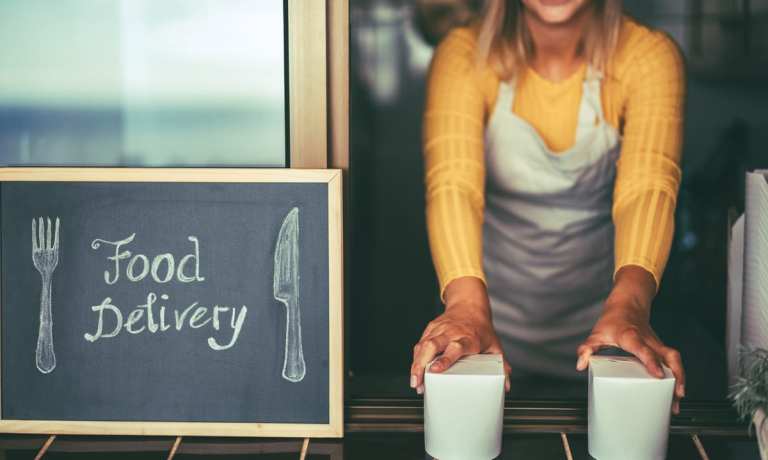The concept of “ghost kitchens” – dining establishments that only offer food on delivery, with no eat-in option – is not an invention of the COVID-19 pandemic. They’ve long been whispered about as a potential dining segment disruptor when partnered with the boom in food delivery services over the last several years.
But as the last eight or so months have made increasingly obvious, the post-pandemic dining landscape is a very different place. As PYMNTS data show, consumers are increasingly digitizing their dining habits.
According to the latest edition of the PYMNTS/Paytronix Order to Eat Tracker, consumers’ use of digital channels to order their meals has skyrocketed since closures officially started shutting down in-person dining in March. Delivery services, on the whole, have grown 20 percent over the past five years, and online food delivery revenue is projected to hit $24 billion by 2023.
Consumers have rewritten and relocated the restaurant dining experience from the tableside to the internet, creating something of a perfect storm of conditions for an explosion of ghost kitchen experiments, care of the inventiveness that comes with necessity. Minneapolis restaurant owner Luke Shimp converted the kitchen of his Red Cow Uptown restaurant to the Kenwood Food and Beverage, a virtual food hall that he opened about a month ago.
“My idea was [to] make a virtual food hall, where it has multiple brands inside, but … you order it online. And it’s all for delivery or takeout,” Shimp said of the new concept to local media. “We took this opportunity to create some new concepts and have them on hand, in case we lose additional seating in the future with the pandemic. If we have to scale back to 25 percent or takeout only, we’d be able to keep filling [orders] with these ghost kitchen concepts.”
The ghost kitchen has also allowed Shimp to bring back 270 of the 400 workers he was forced to furlough in early March due to the shutdowns.
Advertisement: Scroll to Continue
But ghost kitchens are also coming into fashion with larger brands looking to tap the low-overhead, higher-margin business opportunity they represent. Wendy’s, for example, recently opened a ghost kitchen location in partnership with Reef Kitchens in Toronto.
“Our urban business in Canada is underpenetrated,” Stephen Piacentini, Wendy’s vice president of global restaurant development and recruiting, said in an interview. “This helps us creatively get into spots [where] we didn’t have near-term plans with brick and mortar.”
And ghost kitchens, reports indicated, are expanding their presence at all levels of dining. In Phoenix, Japanese fine-dining restaurant Shimogamo was looking for ways to go digital, and settled into the ghost kitchen model as a means of expanding operations without the cost of building a second location, operator Mika Otomo told Restaurant Business.
“I was just seeing this ceiling in expanding and growing further,” Otomo said. “I just wanted to explore the different opportunities out there. The ghost kitchen presented an opportunity at the lowest initial cost.”
Shimogamo’s collaboration with the ghost kitchen firm Kitchens United in December turned out to be very successful. The pandemic had shut down its dining room, Otomo noted, but its ghost kitchen business grew by 400 percent. She believes the business would have survived the pandemic without the expansion, but it would have been “much harder.”
It seems ghost kitchens have hit their stride in an environment where digital dining options are incredibly appealing to consumers. But can it last?
Will Ghost Kitchens Go the Distance?
While 2020 has been a big year for ghost kitchens, some critics have likened their success to a “house of cards” likely to topple in 2021. For all of their upside, some believe ghost kitchens require the rarefied environment of 2020 to survive, as consumers’ preference for digital dining is likely to decrease somewhat in an environment where dining out becomes an option again.
Indeed, PYMNTS/PayPal’s consumer shopping habits survey indicated that while many of the digital switches consumers have made in the last several months seem likely to stick post-pandemic, restaurants were unique in that dining out was the only activity that consumers seem more eager to do in person now than they did in March. The share of those who plan to go back to their former dining-out habits increased by 3 percent between April and September. Consumers have learned to love the new normal in many ways – but when it comes to eating, there is apparently always something to be said for having someone else cook, serve and clean up the entire meal.
Which means when it comes to the rise of ghost kitchens on the back of the great digital dining explosion, it’s still something of a wait-and-see when it comes to how much of the model will go the distance in a post-pandemic world.




